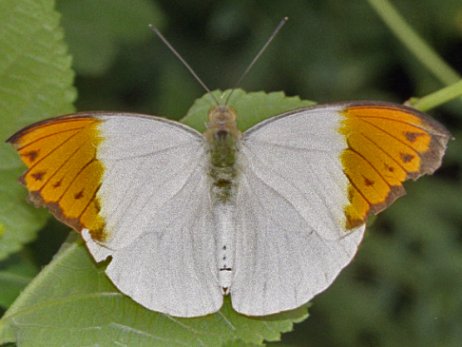
A former student of mine recently alerted me to a study that was published in the Proceedings of the National Academy of Sciences. The authors were studying the proteins found in the wings of a great orange tip butterfly, Hebomoia glaucippe. As they sorted through what they found, they were surprised to find a toxin known as glacontryphan-M.1 The fact that it is a toxin wasn’t surprising to them. After all, Monarch butterflies have cardiac glycosides in their bodies, which are toxic to many birds.2 It is thought that this is a defense mechanism, because birds that eat a monarch butterfly and get sick are unlikely to eat more monarch butterflies.
Here’s what’s surprising: the toxin is also found in a sea snail known as the marble cone snail, Conus marmoreus.3 You can see how it gets its name:

The marble cone snail uses the toxin for hunting. It injects the toxin into its prey, paralyzing it. That makes the prey very easy to eat. Obviously, the researchers were surprised to find the same toxin in two separate species that are supposed to be distantly related in terms of evolution. More importantly, they were surprised at the fact that the two toxins are chemically identical.
How did this toxin end up in two different animals that supposedly evolved along completely different lines? Well, the currently fashionable answer is convergent evolution. In the end, it is thought that the marble cone snail evolved the toxin to effectively kill prey, while the great orange tip butterfly evolved the toxin in order to ward off predators. In an incredibly remarkable coincidence, the two toxins just happen to be identical. As I have pointed out previously (here, here, here, here, here, here, and here), convergent evolution is becoming more and more of a problem for the hypothesis of evolution.
After all, it is thought that similar structures (or similar genes or similar chemicals) in different organisms are the result of evolutionary inheritance. In other words, similar features are found in organisms that are related by common ancestry. However, more and more cases of incredible similarities are being found in organisms that couldn’t possibly be closely related in evolutionary terms. As a result, convergent evolution is being invoked more and more to explain around these similarities.
Unfortunately, there is no objective way to distinguish between convergent evolution and common ancestry. As a result, the only way an evolutionist can decide whether a similarity is the result of convergent evolution or common ancestry is to first check the hypothesis of evolution. If common ancestry between the two organisms is consistent with the hypothesis, then the similarity is the result of common ancestry. If not, it is the result of convergent evolution.
For example, in a previous article, I discussed an antibody that binds to a specific variant of a protein that is found in birds. That antibody was also able to bind to proteins found in dinosaur bones. A commenter asked if this gave support to the view that birds evolved from dinosaurs. The problem is that since evolutionists have no objective way to determine whether a similarity is the result of common ancestry or convergent evolution, there is no way to know. Since the currently fashionable view is that birds evolved from dinosaurs, most evolutionists would say that the similarity between the protein in birds and dinosaurs is a result of common ancestry. However, if another view becomes fashionable, the similarity between the two proteins will be explained as convergent evolution.
This doesn’t seem to be a very scientific approach to analyzing the similarities between organisms, but it is what evolutionists are forced to do in order to explain what is observed in nature.
REFERENCES
1. Narkhyun Baea, Lin Lia, Martin Lödl, and Gert Lubeca, “Peptide toxin glacontryphan-M is present in the wings of the butterfly Hebomoia glaucippe (Linnaeus, 1758) (Lepidoptera: Pieridae),” Proceedings of the National Academy of Sciences of the United States of America doi: 10.1073/pnas.1209632109, 2012
Return to Text
2. Brower LP, McEvoy PB, Williamson KL, and Flannery MA, “Variation in cardiac glycoside content of monarch butterflies from natural populations in eastern North America,” Science 177:426-428, 1972.
Return to Text
3. Hansson K, Ma X, Eliasson L, Czerwiec E, Furie B, Furie BC, Rorsman P, and Stenflo J., “The first gamma-carboxyglutamic acid-containing contryphan. A selective L-type calcium ion channel blocker isolated from the venom of Conus marmoreus,” Journal of Biological Chemistry 279:32453-32463, 2004.
Return to Text

I always thought similarity between species was a sign of good design 🙂 As a software developer, if you do not reuse your code when you can, it is considered wasteful.
Glacontryphan-M was present in both species and chemically identical.
When would the same chemical be different (across species or not)?
That’s an excellent question, D. Perrine. I guess I should have explained that. I think it would be best done in a post, however. Let me use my next post to explain how the same chemical can be different in different species.